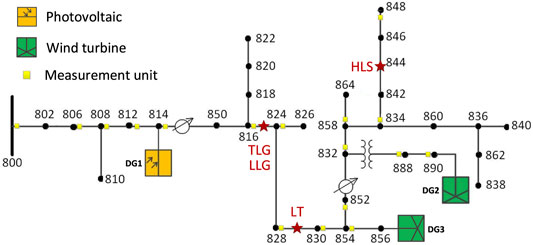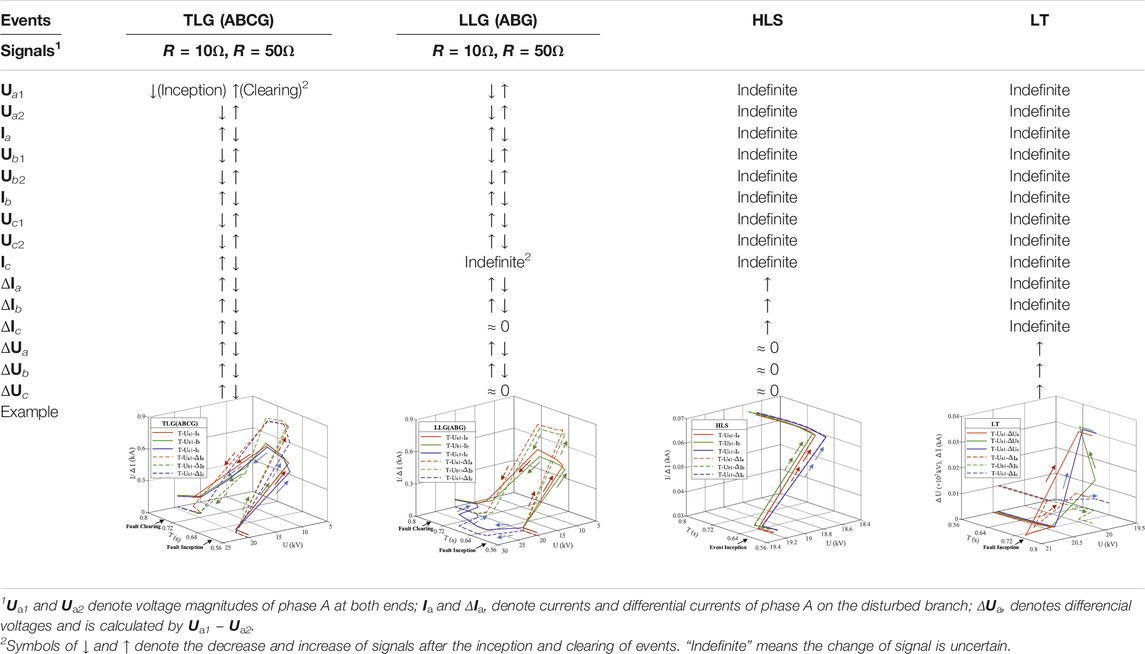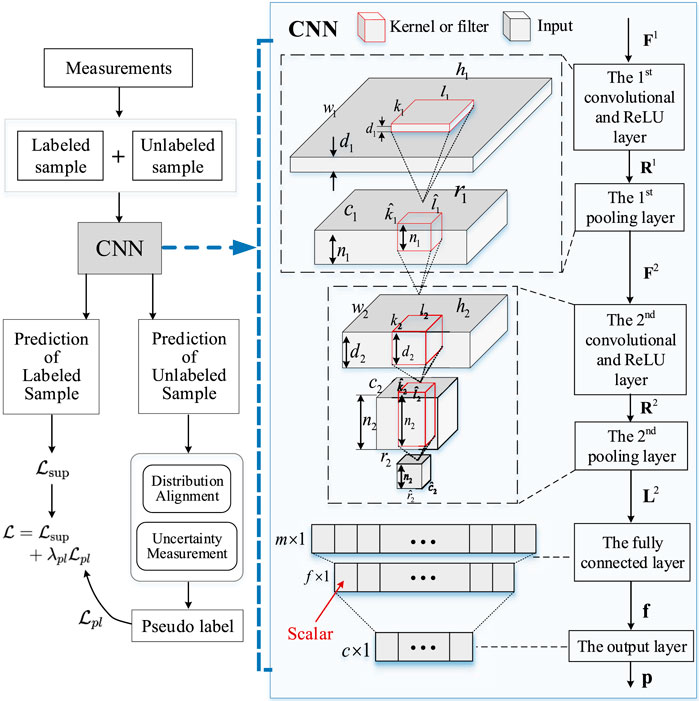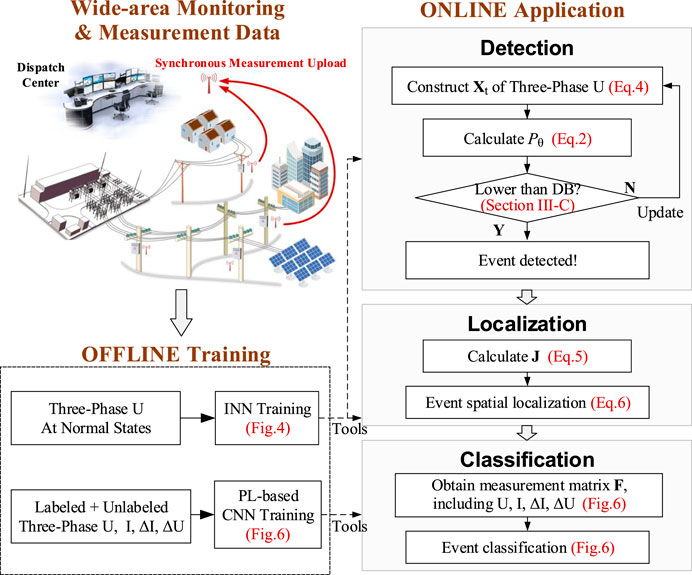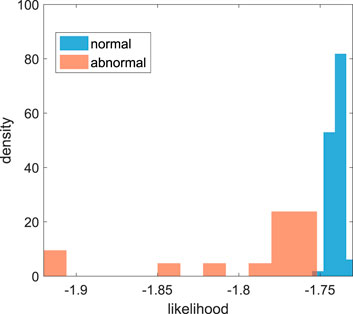- 1Department of Electrical Engineering, State Energy Smart Grid Research and Development Center, Shanghai Jiaotong University, Shanghai, China
- 2Key Laboratory of Machine Perception (MoE), School of EECS, Peking University, Beijing, China
- 3Pazhou Laboratory, Guangzhou, China
- 4School of Electronic Information and Communication, Huazhong University of Science and Technology, Wuhan, China
Anomalous event detection and identification are important to support situational awareness and security analysis in power grids. Particularly, the distribution network is with complicated topology, variable load behaviors, and integration of nonlinear distributed generators (DGs), which is difficult to implement complete modeling mathematically. With the deployment of advanced measurement devices such as μPMUs in distribution networks, massive data containing rich system status information becomes available. In this paper, a framework for event detection, localization, and classification is studied to extract event features from measurements in distribution networks. Specifically, a method based on an invertible neural network (INN) is employed to model the complex distributions of normal-state measurements offline in a flexible way. It then establishes explicit likelihoods as the indicator to enable real-time event detection. Furthermore, a Jacobian-based method is utilized for spatial localization. Finally, as the events in practical power grids are mostly recorded unlabeled, the pseudo label (PL) based approach, superior in the separating ability for events under a low labeling rate, and is used to implement event classification. Several typical types of events simulated in the IEEE 34-bus system and real-world cases in a low-voltage system verify the effectiveness and superiorities of the framework.
1 Introduction
In power grids, anomalous events refer to incidents that violate well-defined normal operating conditions. The detection and identification of them are important to support situational awareness and security analysis in power grids. In distribution networks, anomalous events are mainly composed of short-circuit faults and tripping events, which can cause the voltages and currents to exceed limits, be out of allowed ranges, and generate asymmetries. Lack of monitoring to these events could fail to make necessary and immediate responses, decreasing the safety, reliability, and quality of power supply, and even leading to more serious contingencies (Samuelsson et al., 2006). Therefore, accurately detecting events, identifying their locations, and determining their classifications are essential, so that the system status can be comprehensively assessed and proper actions can be taken before any sporadic event escalates to worse effects.
Traditional model-based approaches for event recognition are usually aimed at a certain event signal or topology. Event characteristics are analyzed based on different levels of assumptions and simplifications (Wang et al., 2018) (Wei et al., 2021). However, these approaches are difficult to model each type of event completely and accurately, and are not adaptable to power systems’ complex, and changeable operation status (Song et al., 2015).
To cope with the complexity and uncertainty of system operations, constructing smart distribution networks has been accelerated, which aims to improve real-time monitoring, situational awareness, and rapid control. With the background, the large-scale deployment of measuring devices, such as μPMUs, has been promoted, and allowing for the real-time transmission of massive data in distribution networks. Data-driven approaches of event analysis utilize the rich information contained in signals, relying on no assumptions or simplifications of the system modeling. They can generally provide better robustness to the variations of systems’ topologies and operations, thus having an extensive application prospect.
In literature, various data-driven approaches have been applied in the area of event analysis. The principal component analysis (PCA) is used in (Xie et al., 2014) to reduce the dimension during the feature extraction for event detection. In (Ahmed et al., 2021), event detection, localization, and classification are implemented by utilizing the deep autoencoder (DAE). The features of cascading events are analyzed and trained by a shallow convolutional neural network (CNN) in (Li and Wang, 2019). In (Wang et al., 2019), the measurements at the normal state are modeled by a one-class support vector machine (OCSVM) hence realizing the event detection. An enhanced long short-term memory (LSTM) network is used in (Li et al., 2021) to implement the fast event detection of a system containing renewable energy. In (Liu et al., 2019), an approach is proposed based on the local outlier factor (LOF) to detect and locate events using reduced PMU data. In (He et al., 2019), invisible power usage events are detected by high-dimensional statistics in random matrix theory (RMT). In (Pandey et al., 2020), density-based spatial clustering is applied to classify events into short circuit faults and those caused by a significant imbalance of active and reactive powers, and by identifying the types of disturbed measurements.
However, how to appropriately use the online measurements and realize the event detection, localization, and classification in a more effective way deserves further consideration. For the existing data-driven approaches, some limitations exist:
1) Feature selection is not paid attention to, especially for the event classification. Various measurements exhibit different characteristics, but they are usually utilized without more considerations of applicability. For example, voltage magnitudes are utilized in (Tong et al., 2021) or together with current magnitudes in (Wilson et al., 2020), but their changes are indefinite and can confuse events on some occasions.
2) Parameters or thresholds are required to be preset, and they are strongly depended on by some methods (Xie et al., 2014; Wang et al., 2019; Ahmed et al., 2021). The optimal settings are hard to adapt to all datasets.
3) Unlike transmission networks, statistical properties of the fluctuated measurements in distribution networks cannot be approximated as a Gaussian distribution or other typical distributions. More nonlinearities and uncertainties are exhibited, so the theoretical basis of many methods is invalid.
4) Measurements of practical power systems exhibit significant imbalance, which means the measurements obtained at normal states are significantly larger than those obtained at anomalous states. Besides, only a few events are identified and labeled by operators (about 2%) (Wilson et al., 2020). It hinders the use of supervised approaches (Li and Wang, 2019; Yadav et al., 2019; Li et al., 2021), while unsupervised approaches (Pandey et al., 2020; Wilson et al., 2020; Ahmed et al., 2021) can only make identifications roughly.
To cope with the above problems, a semi-supervised framework is studied and employed for event detection, localization, and classification in distribution networks by taking advantage of invertible neural networks (INNs) and pseudo labels (PLs). Offline training is conducted using the INN in (Kingma and Dhariwal, 2018) to learn the distribution of measurements obtained at normal states. The explicit likelihoods can be calculated for event detection, and an input-output Jacobian is utilized for event localization. Then a CNN-and-PL-based approach is explored for event classification. Contributions of this paper are summarized as follows.
1) Based on INNs, the framework can effectively model the complex distributions of measurements obtained at normal states, so as to detect events reliably, and sensitively in distribution networks.
2) The event classification is based on accurate event localization, so the exact signal features around the event location can be utilized, supporting the more precise, and reliable event classification. Further, the combination of voltages/currents and differential currents/voltages is utilized and verified to possess an enhanced ability to distinguish between several principal events in DG-integrated distribution networks.
3) The event analysis, especially the event classification, under the low labeling rate of measurements is figured out by the CNN-and-PL-based approach. The significant advantages over other approaches in solving this problem have been verified in distribution networks.
The rest of this paper is organized as follows. In Section 2, the characteristics of various kinds of measurements are illustrated when different events occur. Requirements for event analysis are also discussed. In Section 3, a semi-supervised framework is studied for event detection, localization, and classification in distribution networks with the integration of DGs. Case studies are conducted in Section 4, where both simulated and real-world data are utilized to make the verifications. Finally, conclusions are given in Section 5.
2 Problem Formulation
Different events will make voltages, currents, or other measurements exhibit different characteristics. Selecting various measurements or their combinations to carry out event analysis will make variable influences on the sensibility and reliability. In this section, considering the characteristics of distribution networks, the representative features of different kinds of measurements are analyzed, and a specific combination is selected for event classification. In addition, the limitations of some typical methods to learn and model the behaviors of real-world measurements are illustrated, and requirements of methods for event detection and classification are discussed.
2.1 Selection of Measurements
Three-phase voltages and currents are usually used for event detection in data-driven approaches, as they effectively reflect the operating status and can be directly obtained by online monitoring devices. However, limitations exist when inappropriately using these measurements for event classification.
Some work utilizes voltage magnitudes for event classification (Tong et al., 2021), and some combine the voltages with currents (Wilson et al., 2020). In this section, the characteristics of these measurements are analyzed when four typical events happen in the IEEE 34-bus system, including three-line-to-ground fault (TLG), line-to-line-to-ground fault (LLG), heavy load switching-in event (HLS), and line trip (LT). The topology is shown in Figure 1 with positions of assumed events marked. Three DGs are integrated into the system, i.e., a photovoltaic (PV) at Bus 814, two doubly-fed induction generators (DFIGs) at Bus 856 and Bus 890. For LLG, disturbed phases are set as phases A and B, and the LT is assumed as a three-phase event. A heavy load of 0.35 MW is switched in at Bus 844 for the HLS. The outputs of the PV at Bus 814, the DFIG at Bus 890, and the DFIG at Bus 856 are 0.25, 0.776, and 0.703 MW, respectively. In this situation, the penetration rate of DGs is 48.78%.
Changes of measurements are listed in Table 1. For phase A, magnitudes of voltages at both ends (Ua1 and Ua2), currents (Ia), differential currents (ΔIa) on the disturbed branch, and differential voltages (ΔUa) are listed. Herein, ΔIa is calculated by the sum of current phases at both ends, and ΔUa is the voltage difference between the voltage phases at the two ends. They reflect the leakage current and the voltage drop on the branch, respectively. Curves of T − Ua1 − Ia, T − Ua1 − ΔIa, and T − Ua1 − ΔUa are plotted. It can be observed that only voltage and current magnitudes cannot identify some certain events like HLS and LT. This is because the integration of DGs and the branches existing between two measurement units will make the power flow and the caused voltage drop uncertain on various conditions, including various capacities and positions of DGs, line parameters, load levels, imbalance degrees, and disturbance intensities of events, etc. To this end, only voltage or current magnitudes cannot perform well in event classification. According to the theoretical analysis and comprehensive simulations, a combination of three-phase voltages, currents, differential currents, and differential voltages is demonstrated to be capable of effectively distinguishing between TLG, LLG, HLS, and LT. The characteristics of these measurements under the four events are summarized in Table 1. Therefore, in this paper, such measurement combination will serve as the selected features to implement the event classification.
2.2 Requirements for Event Detection and Classification
2.2.1 Event Detection
Figure 2 shows a typical topology of a medium and low voltage distribution network, where online monitoring data is collected from measurement units distributed in the network. Figure 3A shows three-phase voltage magnitudes recorded at load-side transformers in region A. The sampling interval between every two measurements is 15 min. Since voltage magnitudes are closely related to load levels, curves in Figure 3A exhibit a typical daily pattern, i.e., low voltage in the day and early night for the heavy load, whereas high voltage at midnight for the light load. In addition, voltage measurements show different details between days: fluctuation amplitudes, shapes, and presence of spikes, etc., which are caused by load switching and changes of operating states. The complex, nonlinear, and dynamic characteristics make the modeling of real-world measurements challenging. As a result, methods extracting simple features for event detection malfunction in some situations.
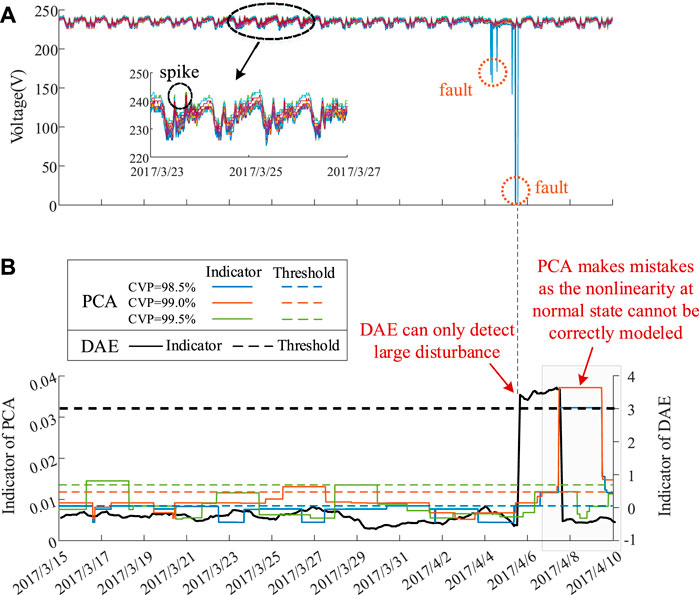
FIGURE 3. (A) Real-world measurements of three-phase voltage magnitudes obtained at load-side transformers; (B) detection results of DAE and PCA under different CVPs.
Here, a DAE-based approach (Ahmed et al., 2021) and a PCA-based approach (Xie et al., 2014) are utilized to detect the faults marked in Figure 3A. Figure 3B shows their detection indicators, i.e., Z-score and mean absolute error (MAE). In Figure 3B, Z-score identifies the fault on April 5th with a significant voltage drop but misses the fault on April 4th. This is because the simple structure of DAE cannot model complex distributions of real-world measurements effectively, and the indicator is not sensitive enough. Besides, the detection threshold (a constant, i.e., three) set in (Ahmed et al., 2021) is questionable because a fixed threshold is hard to be appropriate for all situations. In Figure 3B, MAE is significantly affected by a pre-defined parameter, i.e., cumulative variance percentage (CVP). When the CVP is selected as 98.5%, 99%, and 99.5%, PCA cannot accurately detect the two faults in Figure 3A. PCA is a linear dimension reduction method and cannot effectively deal with nonlinear measurements. Also, a proper CVP is hard to find in advance for all datasets. To this end, two aspects require attention for event detection algorithms in distribution networks: 1) the ability to model complex and nonlinear real-world measurements; 2) the robustness to pre-defined parameters.
2.2.2 Event Classification
Supervised approaches for event classification are dependent on large amounts of labeled data for training, such as (Li et al., 2021) and (Yadav et al., 2019). However, only about 2% of the total number of recorded events are labeled by the operators in a hand-crafted way (Wilson et al., 2020), which hinders their practical applications. Unsupervised approaches require no prior labeling of samples, but can only classify events roughly. Examples include (Wilson et al., 2020) and (Ahmed et al., 2021), which can only distinguish the number of disturbed phases but cannot further determine the specific type of events. Besides, active and reactive events are identified in (Ahmed et al., 2021) and (Pandey et al., 2020) simply by the category of disturbed measurements. In contrast, semi-supervised approaches simultaneously utilize labeled and unlabeled data, and thus they can realize refined classification with only a limited number of labeled samples. Therefore, semi-supervised approaches are preferable for event classification in practical applications.
3 Event Detection, Localization, and Classification Based on Invertible Neural Networks and Pseudo Labels
In this section, a framework is introduced for event detection, localization, and classification based on INNs and PLs. Event detection and localization are realized by INNs, and a PL-based is utilized to classify the events with measurements obtained at disturbed locations.
3.1 Likelihood-Based Event Detection
Likelihoods measure the probability that a sample belongs to a certain distribution. If a sample follows the distribution, the likelihood is high, and vice versa (Myung, 2003). In power grids, normal measurements are abundant whereas there is little anomalous data. A straightforward idea for event detection is that distributions of normal measurements are first learned and parameterized. At monitoring time, likelihoods of unseen measurements are calculated under the learned distribution. Low likelihoods indicate the occurrence of events.
Assume that
where g is the inverse of f,
Further, assume that the base density pY(y) and the function f are parameterized by vectors ϕ and θ. Given a set of normal measurements (denoted as
where the first term is the log-likelihood of normal measurements under the base density, and the second term (frequently called the log-determinant or volume correction) accounts for the change of volume induced by the transformation g.
The main procedure for event detection includes two steps. Firstly in the training phase, parameters of the function f (i.e., θ) and the base density pY(y) (i.e., ϕ) are adjusted to maximize the log-likelihood
3.2 Invertible Neural Networks
INNs can model complex distributions from a simple base distribution via a set of invertible and differentiable transformations. Hence, they process remarkable representation abilities for complex, nonlinear measurements obtained in the real world. For INNs, efficient calculation of log-determinant is particularly important because they are repeatedly computed in Eq.2 during training. In this paper, we utilize a computationally efficient model named Glow despite various architectures of INNs (Kingma and Dhariwal, 2018). Glow introduces Flow (Kingma and Dhariwal, 2018) to the multi-scale architecture proposed in (Dinh et al., 2016). In Figure 4, inputs (i.e., normal measurements Z) are first squeezed by the squeeze layer to permutate the dimension. Subsequently there are K Flows, and each Flow contains three components:
• Actnorm layer: Actnorm is short for activation normalization. It performs an affine transformation of inputs using a scale and bias parameter, such that the outputs per channel have zero mean and unit variance.
• Invertible 1 × 1 convolution: Permutation of dimensions is necessary for flows to ensure that dimensions can affect each other after sufficient steps of the Flow. A 1 × 1 convolution with an equal number of input and output channels is equivalent to a permutation operation of dimensions and can be computationally efficient (Kingma and Dhariwal, 2018). The log-determinant of an invertible 1 × 1 convolution of an h × w × c tensor h with c × c weight matrix W is
The cost of computing det(W) is
• Affine coupling layer: Glow follows the computationally efficient affine coupling layer introduced in (Dinh et al., 2014), which consists of split and concatenation, a nonlinear mapping, and a permutation.
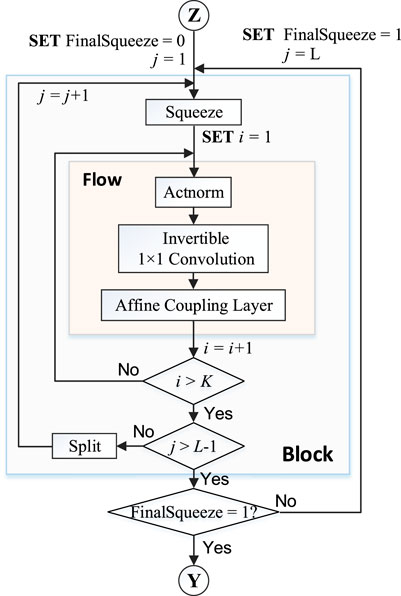
FIGURE 4. Architecture of Glow. The Flow is introduced by (Kingma and Dhariwal, 2018) to the multi-scale architecture proposed in (Dinh et al., 2016).
In Figure 4, the squeeze layer, K flows, and the split layer (reverse of the squeeze layer) are collectively called a block. The multi-scale architecture contains L − 1 whole blocks and one block without the split layer. Finally, the output of the multi-scale architecture are known random variables Y. More details of Glow can be found in (Dinh et al., 2014; Dinh et al., 2016; Kingma and Dhariwal, 2018).
3.3 Event Localization Using Input-Output Jacobian
For practical applications, online measurements (such as three-phase voltage magnitudes) truncated by moving windows are obtained as input samples of INNs, so that explicit likelihoods can be calculated in real-time for situational awareness. Let the column vector
Denote the likelihood estimated by the trained INN as PΘ. As is described in Section 3.1, the trained INN assigns lower likelihoods to abnormal samples than normal ones. For moving windows, once the likelihood is lower than a decision boundary (DB), events are deduced to occur, and it requires further analysis.
To spatially locate the detected event, an input-output Jacobian is calculated by the trained INN, so that the monitoring channel that contributes the most to the low likelihood can be determined. Note that xi,k contained in Eq.4 is the measurement obtained in the ith monitoring channel at the kth sampling point. Then we can measure the contribution of xi,k to the output by
where PΘ is the output likelihood, X is the input (observation matrix) with entries xi,k, and J is the input-output Jacobian whose entry ji,k measures the contribution of xi,k to PΘ, i ∈ (1, … ,, N), k ∈ (1, … ,, T). If the norm of ji,k is small, the entry xi,k only affects PΘ slightly. Otherwise, the entry xi,k has a large impact on PΘ, if the norm of ji,k is large. This inspires us to find xi,k contributing the most to the low likelihood by
where η and τ indicate the spatial location and the occurring time of the event. Figure 5 gives a schematic diagram for event localization.
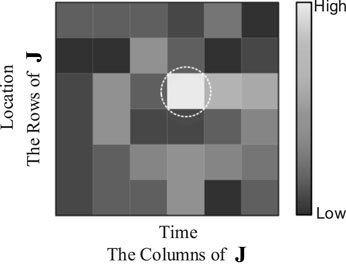
FIGURE 5. Schematic diagram for event localization. The maximum entry of input-output Jacobian of INN is utilized to locate the event spatially.
3.4 Event Classification Based on Pseudo Labels
According to Section 2.1, voltages/currents and differential currents/voltages are appropriate features for event classification. Figure 6 gives an overview of the PL-based approach, which is semi-supervised with only part of the samples labeled. Let
• the supervised loss
• the pseudo-labeling loss
Both labeled and unlabeled samples are trained with a shared backbone of CNN with cross-entropy loss. For c-class classification, the supervised loss is calculated as
with
with
For typical PL-based methods, the pb of an unlabeled sample ub is directly obtained by the prediction vector
• Distribution alignment: Inspired by (Berthelot et al., 2019), prediction vectors are normalized to make category distributions homogeneous. Specifically, a running average of prediction vectors is calculated for unlabeled samples and denoted as
• Uncertainty measurement: To enhance the performance of classification, only samples with high-precision PLs are selected for re-training. Here, the maximum entry of
In summary, our modified pseudo-labeling loss is formulated as
where 1 is an indicator function, and the loss function is
where λpl denotes the balancing factor that controls the weight of the pseudo-labeling loss.
3.5 Convolution Neural Networks
To make this paper self-contained, a brief introduction is given for the CNN classifier in this section. As is shown in Figure 6, the CNN we construct here consists of 2 convolutional layers, 2 Rectified linear units (ReLU) layers, 2 pooling layers, a fully connected layer, and an output layer. The input is a 3-dimensional volume X ∈ Rw×h×d with width w, height h, and depth d. The output is a prediction vector of c classes, and the class with the highest probability indicates the type of the event. Let
After the second pooling layer, the output L2 is reshaped into a vector q ∈ Rm and then input into the fully connected layer. Denote the output of the fully connected layer as f ∈ Rf, and finally, the prediction vector p ∈ Rc can be computed by
Based on the research in Section 3, the flowchart of the framework for event detection, localization, and classification is presented in Figure 7.
4 Case Studies
In this section, the framework for event detection, localization, and classification is validated with both simulated data and real-world online monitoring data. Comparisons with other approaches are also given in this section.
4.1 Case Studies on Event Detection and Localization
4.1.1 Simulated Data
The INN-based method is tested with the IEEE 34-bus system shown in Figure 1 for event detection. According to different distances to generators, several event locations are set for TLG, LLG, HLS, and LT, as is shown in Table , where FCT, FLL, and GR represent fault clear time, fault location in line, and ground resistance. Three-phase voltage magnitudes are measured by 17 measurement units, and the total dimensionality of measurement variables is 51. Simulated data is generated with PSCAD. The simulation step is set as 50 μs, and the phasor is calculated for every cycle in the 50 Hz system. The simulation time of each sample is set as one second. Gaussian noise with a signal-to-noise ratio (SNR) of 50 dB is added to mimic normal fluctuations. Finally, a total of 2000 normal samples of size 51 × 50 are utilized for training, whereas the test set contains 1,600 samples, and 400 of them are anomalous.
Figure 8 shows the detection result, i.e., likelihood distributions for both normal and abnormal samples in the test set. It can be observed that the trained INN assigns lower likelihoods to abnormal samples than normal ones, which verifies the feasibility of likelihoods serving for classification. Then a DB can be naturally designed to distinguish abnormal samples. It is noted that in this case, the lowest likelihood for abnormal samples is −9,892. For an intuitive comparison, we just show samples with likelihoods larger than −2 in Figure 8.
4.1.2 Real-World Data
In this part, online monitoring data obtained from a distribution network in Hangzhou city of China is used to validate the approach. The distribution network contains 200 feeder lines with 8,000 load-side transformers. Here, the measurements in Figure 3A are utilized for analysis. The feeder line contains 14 load-side transformers, and the total dimensionality of three-phase voltage magnitudes is 42. The online monitoring data were sampled during 2017/3/1 00:00:00 ∼2017/4/9 23:45:00. Amongst, normal measurements during 2017/3/1 00:00:00 ∼2017/3/14 23:45:00 are utilized to train the INN. The remaining obtained during 2017/3/15 00:00:00 ∼2017/4/9 23:45:00 are tested. A continuously moving window of size 42 × 192 is utilized to truncate the datasets. Raw measurements of the test set and the likelihood curve obtained by the trained INN are shown in Figure 9A,B, respectively. The DB is determined as the minimum value of likelihoods obtained in the training set. On April 4th and April 5th, multiple events occurred successively, and measurements of the 2 days are zoomed in as Figure 9A. It can be observed that likelihoods in Figure 9B first drops below the DB slightly on April 4th and then drops significantly on April 5th, indicating a more serious event on April 5th.
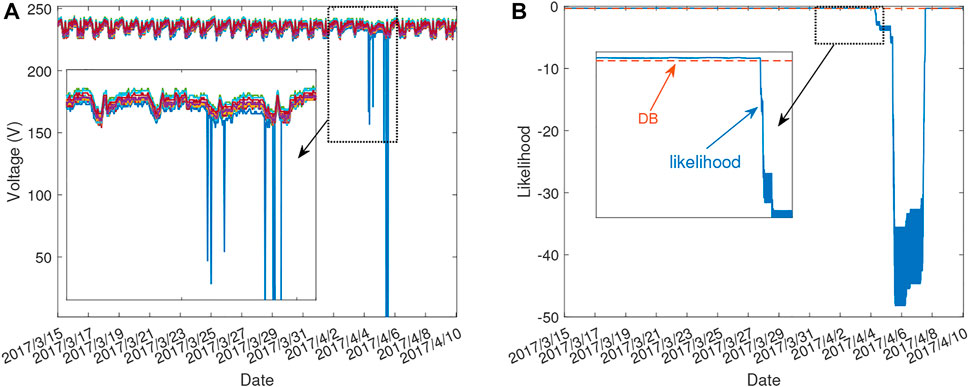
FIGURE 9. (A) Measurements of three-phase voltages obtained at load-side transformers in the test set; (B) Likelihoods obtained by the trained INN, samples with likelihoods lower than the DB indicate the occurrence of events.
Further, the observation matrix truncated on April 5th is utilized for event localization. The input-output Jacobian is presented as a 3-D map in Figure 10. The maximum entry of the Jacobian is circled and the Location Index is determined as 29, indicating the B-phase of the 10-th transformer, and which matches the event records. In this case, three-phase voltages are obtained at load-side transformers. However, on some feeders in distribution networks, only line-to-line voltages can be acquired for the economy. In this situation, the localization accuracy may be reduced, but the disturbed location can still be determined as the nearby position where three-phase voltages can be acquired (e.g., substations, switching stations, and load-side transformers).
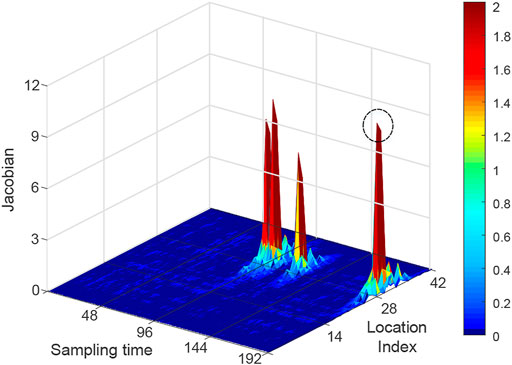
FIGURE 10. The 3-D map of input-output Jacobian for an observation matrix truncated on April 5th. The maximum entry is circled and the Location Index match the recorded locations.
4.1.3 Comparisons With Other Approaches
In this part, the INN-based approach is compared with other approaches for event detection, including DAE (Ahmed et al., 2021), PCA (Xie et al., 2014), Gaussian mixture model (GMM) (Catterson et al., 2010), OCSVM (Wang et al., 2019), and K-means (Ozgonenel et al., 2012). Assume that positive samples are abnormal samples with events, whereas negative samples are those obtained at normal states. In order to evaluate the performance of the approaches, four categories of samples are generated according to genuine types and detection results:
• True Positive (TP): abnormal samples (positive samples) that are detected as anomalies (positives);
• False Positive (FP): normal samples (negative samples) that are detected as anomalies (positives);
• False Negative (FN): abnormal samples (positive samples) that are detected to be normal (negatives);
• True Negative (TN): normal samples (negative samples) that are detected to be normal (negatives).
Precision measures the detection accuracy and is given by
Recall is defined as the number of positives the model claims compared to the actual number of positives there are throughout the data. It is given by
Different precision and recall values are achieved when different DBs are set to distinguish between normal and abnormal samples. The higher the precision and recall values, the better the detection performance of one approach. However, a higher recall value generally corresponds to a lower precision value. Therefore, precision-recall curves (PRCs) generated under different DBs are utilized for a comprehensive evaluation of approaches, and we compute the area under the PRC, termed the AP by
where “p” denotes precision, “r” denotes recall. The higher the AP is, the better the detection performance, AP
• DAE: Observation matrices obtained at normal states are utilized for training. The loss function is the reconstruction error (RE) of input samples and is calculated by MSE as
• PCA: PCA is a classical dimensional reduction method. Given an observation matrix
• GMM: GMM is a clustering-based method that approximates complex distributions with a linear superposition of multiple Gaussian distributions. For GMM, the number of clustering categories is pre-designed, and assume that normal samples are clustered with smaller category indices. A sample is considered to be abnormal if the category index is larger than the DB.
• OCSVM: OCSVM learns a hyperplane to enclose normal samples. Signed distances to the separating hyperplane are positive for an inlier and negative for an outlier. A sample is considered to be abnormal if the signed distance is smaller than the DB.
• K-means: Samples are clustered by k centers. Assume that normal samples are clustered with smaller indices, and a sample is considered to be abnormal if the category index is larger than the DB.
Both simulated data and real-world data are utilized for comparison. For simulated data, the training set and test set are the same as in Section 4.1.1. For real-world data, 50 feeder lines with 120 event records during 2017/3/20 00:00:00 ∼2017/4/9 23:45:00 are analyzed. A moving window with 96 sampling points is utilized to truncate the datasets. For the simulated data, PRCs, and APs of different approaches are shown in Figure 11. For the real-world data, APs of different approaches are calculated and given in Table 3. It can be observed that INN achieves the highest AP for both simulated data and real-world data. For DAE, PCA, GMM, K-means, and OCSVM, AP is significantly lower for real-world data than for simulated data. This is because real-world data exhibits complex and nonlinear properties, which is more difficult to model than simulated data. Specifically, PCA is a linear dimension reduction approach and is not applicable for nonlinear measurements. DAE is a nonlinear generalization of PCA. However, it is vulnerable to sporadic spikes and random fluctuations because of the simple structure. K-means, GMM, and SVM are strongly dependent on pre-designed parameters, whose optimal settings are hard to find for all datasets. INN, by contrast, and is capable of modeling and characterizing complex distributions without empirical settings or assumptions. As a result, it outperforms other approaches, especially in dealing with real-world datasets.

FIGURE 11. PRCs of different approaches with simulated data in the IEEE 34-bus system. APs of INN are larger than others, which verifies the advantages of INN.
4.2 Case Studies on Event Classification
In this section, the PL-based approach is compared with other approaches for event classification, including CNN (Li and Wang, 2019), deep neural network (DNN) (Yadav et al., 2019), and LSTM (Li et al., 2021). Different events are generated as in Table 2. Received operational characteristics (ROC) and the area under the ROC curve (AUC) can measure the capability of a classifier to distinguish between multiple classes and they serve as evaluation metrics. For events of type i, the ROC is calculated by assuming type i as the positive class, and all others as negative classes. Then the average ROC is defined by TPRaver against FPRaver with
where n is the number of classes. The average ROC curve is desired to be far away from the diagonal line, and it indicates an enhanced separating ability for different events. The AUC reveals the capability of a classifier quantitatively and AUC ∈ [0, 1]. A larger AUC indicates better performance in classification.
For the training set and test set, numbers of cases for each event are 400 and 150, respectively. For a fair comparison, rates of labeled samples are set as 10% and 1% for CNN, DNN, LSTM, and PL. Figure 12 shows ROC curves and corresponding AUCs of different approaches under 10% and 1% labeling rate. It can be observed that the PL-based approach obtains the largest AUC, especially under a low labeling rate of 1%. This benefits from the re-training process using samples with high-precision PLs. In this way, the rate of labeled samples becomes higher after epoches of training, and the PL-based approach achieves the effect comparable to supervised learning in the test set. Therefore, the PL-based approach outperforms the CNN, DNN, and LSTM-based approaches under a low labeling rate.
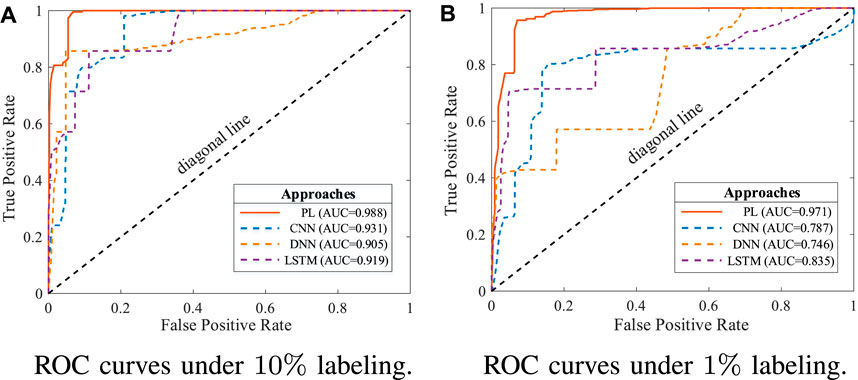
FIGURE 12. ROC curves and AUCs of approaches under 10% and 1% labeling rates. ROC curves are desired to be far away from the diagonal line. (A) ROC curves under 10% labeling. (B) ROC curves under 1% labeling.
5 Conclusion
In this paper, a framework is presented for event detection, localization, and classification in distribution networks to realize real-time situational awareness and event analysis. Key findings are summarized as follows.
1) The INN-based approach outperforms others in event detection with a higher AP due to INN’s superior ability in modeling complex, nonlinear measurements.
2) Based on feature analysis of several principal events, including TLG, LLG, HLS, and LT, we verify that a combination of voltages/currents and differential currents/voltages possesses distinctive characteristics for different events and is appropriate for event classification.
3) For event classification, the PL-based approach shows superiority over CNN, DNN, and LSTM-based approaches, and the AUC is increased by 10% under a low labeling rate (1%).
Data Availability Statement
The original contributions presented in the study are included in the article/Supplementary Material, further inquiries can be directed to the corresponding author.
Author Contributions
FY: conceptualization, writing—original draft. ZL: methodology, formal analysis. YZ: methodology, visualization. XH:writing—review and editing. QA: methodology, supervision. RQ: visualization, supervision.
Conflict of Interest
The authors declare that the research was conducted in the absence of any commercial or financial relationships that could be construed as a potential conflict of interest.
Publisher’s Note
All claims expressed in this article are solely those of the authors and do not necessarily represent those of their affiliated organizations, or those of the publisher, the editors and the reviewers. Any product that may be evaluated in this article, or claim that may be made by its manufacturer, is not guaranteed or endorsed by the publisher.
References
Ahmed, A., Sajan, K. S., Srivastava, A., and Wu, Y. (2021). Anomaly Detection, Localization and Classification Using Drifting Synchrophasor Data Streams. IEEE Trans. Smart Grid 12 (4), 3570–3580. doi:10.1109/tsg.2021.3054375
Berthelot, D., Carlini, N., Cubuk, E. D., Kurakin, A., Sohn, K., Zhang, H., et al. “Remixmatch: Semi-supervised Learning with Distribution Alignment and Augmentation Anchoring,” arXiv preprint arXiv:1911.09785, accesed 13 Feb 2020 2019.
Catterson, V. M., McArthur, S. D. J., and Moss, G. (2010). Online Conditional Anomaly Detection in Multivariate Data for Transformer Monitoring. IEEE Trans. Power Deliv. 25 (4), 2556–2564. doi:10.1109/tpwrd.2010.2049754
Dinh, L., Krueger, D., and Bengio, Y., “Nice: Non-linear Independent Components Estimation,” arXiv preprint arXiv:1410.8516, accesed 30 Oct 2014 2014.
Dinh, L., Sohl-Dickstein, J., and Bengio, S., “Density Estimation Using Real Nvp,” arXiv preprint arXiv:1605.08803, accesed 27 May 2016 2016.
He, X., Chu, L., Qiu, R. C., Ai, Q., Ling, Z., and Zhang, J. (2019). Invisible Units Detection and Estimation Based on Random Matrix Theory. IEEE Trans. Power Syst. 35 (3), 1846–1855.
Kingma, D. P., and Dhariwal, P. (2018). “Glow: Generative Flow with Invertible 1x1 Convolutions,” in Advances in Neural Information Processing Systems. Montréal, Canada: Curran Associates, 10215–10224.
Lee, D.-H. (2013). “Pseudo-label: The Simple and Efficient Semi-supervised Learning Method for Deep Neural Networks,” in Workshop on challenges in representation learning, Atlanta, Georgia, June 16–21 (ICML), 896.
Li, W., and Wang, M. (2019). Identifying Overlapping Successive Events Using a Shallow Convolutional Neural Network. IEEE Trans. Power Syst. 34 (6), 4762–4772. doi:10.1109/tpwrs.2019.2914774
Li, Z., Liu, H., Zhao, J., Bi, T., and Yang, Q. (2021). Fast Power System Event Identification Using Enhanced Lstm Network with Renewable Energy Integration. IEEE Trans. Power Syst. 36 (5), 4492–4502. doi:10.1109/tpwrs.2021.3064250
Liu, S., Zhao, Y., Lin, Z., Liu, Y., Ding, Y., Yang, L., et al. (2019). Data-driven Event Detection of Power Systems Based on Unequal-Interval Reduction of Pmu Data and Local Outlier Factor. IEEE Trans. Smart Grid 11 (2), 1630–1643.
Myung, I. J. (2003). Tutorial on Maximum Likelihood Estimation. J. Math. Psychol. 47 (1), 90–100. doi:10.1016/s0022-2496(02)00028-7
Ozgonenel, O., Thomas, D., Yalcin, T., and Bertizlioglu, I. N. (2012). “Detection of Blackouts by Using K-Means Clustering in a Power System,” in 11th IET International Conference on Developments in Power Systems Protection (DPSP 2012, Birmingham, UK, 23-26 April 2012 (IET), 1–6. doi:10.1049/cp.2012.0079
Pandey, S., Srivastava, A., and Amidan, B. (2020). A Real Time Event Detection, Classification and Localization Using Synchrophasor Data. IEEE Trans. Power Syst. 35 (6), 4421–4431. doi:10.1109/tpwrs.2020.2986019
Samuelsson, O., Hemmingsson, M., Nielsen, A. H., Pedersen, K. O. H., and Rasmussen, J. (2006). Monitoring of Power System Events at Transmission and Distribution Level. IEEE Trans. Power Syst. 21 (2), 1007–1008. doi:10.1109/tpwrs.2006.873014
Song, J., Cotilla-Sanchez, E., Ghanavati, G., and Hines, P. D. (2015). Dynamic Modeling of Cascading Failure in Power Systems. IEEE Trans. Power Syst. 31 (3), 2085–2095. doi:10.1109/TPWRS.2015.2439237
Tong, H., Qiu, R. C., Zhang, D., Yang, H., Ding, Q., and Shi, X. (2021). Detection and Classification of Transmission Line Transient Faults Based on Graph Convolutional Neural Network. CSEE J. Power Energ. Syst. 7 (3), 456–471. doi:10.17775/CSEEJPES.2020.04970
Wang, X., Gao, J., Wei, X., Zeng, Z., Wei, Y., and Kheshti, M. (2018). Single Line to Ground Fault Detection in a Non-effectively Grounded Distribution Network. IEEE Trans. Power Deliv. 33 (6), 3173–3186. doi:10.1109/tpwrd.2018.2873017
Wang, Z., Fu, Y., Song, C., Zeng, P., and Qiao, L. (2019). Power System Anomaly Detection Based on Ocsvm Optimized by Improved Particle Swarm Optimization. IEEE Access 7, 181580–181588. doi:10.1109/access.2019.2959699
Wei, M., Zhang, H., Shi, F., Chen, W., and Terzija, V. (2021). Nonlinearity Characteristic of High Impedance Fault at Resonant Distribution Networks: Theoretical Basis to Identify the Faulty Feeder. IEEE Trans. Power Deliv. doi:10.1109/tpwrd.2021.3074368
Wilson, A. J., Reising, D. R., Hay, R. W., Johnson, R. C., Karrar, A. A., and Daniel Loveless, T. (2020). Automated Identification of Electrical Disturbance Waveforms within an Operational Smart Power Grid. IEEE Trans. Smart Grid 11 (5), 4380–4389. doi:10.1109/tsg.2020.2990079
Xie, L., Chen, Y., and Kumar, P. R. (2014). Dimensionality Reduction of Synchrophasor Data for Early Event Detection: Linearized Analysis. IEEE Trans. Power Syst. 29 (6), 2784–2794. doi:10.1109/tpwrs.2014.2316476
Keywords: distribution network, data-driven, event detection and localization, event classification, invertible neural network, pseudo labels
Citation: Yang F, Ling Z, Zhang Y, He X, Ai Q and Qiu RC (2022) Event Detection and Identification in Distribution Networks Based on Invertible Neural Networks and Pseudo Labels. Front. Energy Res. 10:858665. doi: 10.3389/fenrg.2022.858665
Received: 20 January 2022; Accepted: 07 February 2022;
Published: 17 March 2022.
Edited by:
Bo Yang, Kunming University of Science and Technology, ChinaCopyright © 2022 Yang, Ling, Zhang, He, Ai and Qiu. This is an open-access article distributed under the terms of the Creative Commons Attribution License (CC BY). The use, distribution or reproduction in other forums is permitted, provided the original author(s) and the copyright owner(s) are credited and that the original publication in this journal is cited, in accordance with accepted academic practice. No use, distribution or reproduction is permitted which does not comply with these terms.
*Correspondence: Xing He, aGV4aW5nX2h4QDEyNi5jb20=
 Fan Yang
Fan Yang Zenan Ling2,3
Zenan Ling2,3 Xing He
Xing He